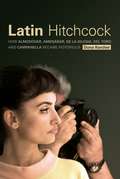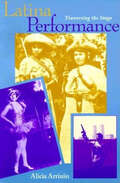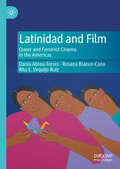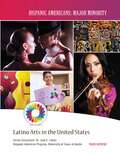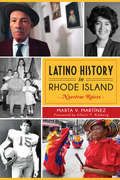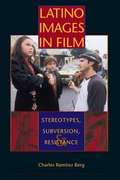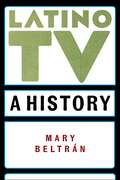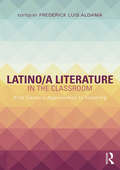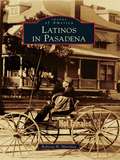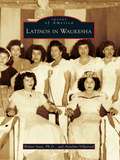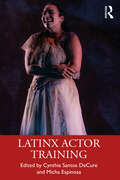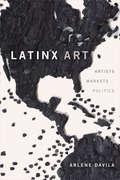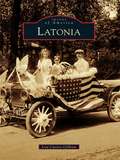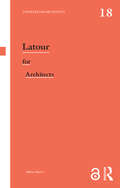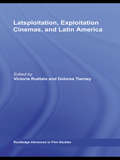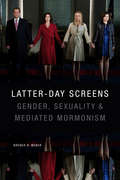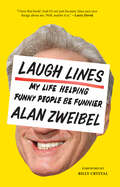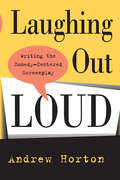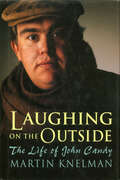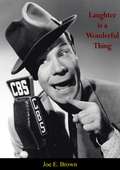- Table View
- List View
Latin Hitchcock: How Almodóvar, Amenábar, De la Iglesia, Del Toro, and Campanella Became Notorious
by Dona KercherThis study explores how five major directors—Pedro Almodóvar, Alejandro Amenábar, Alex de la Iglesia, Guillermo del Toro, and Juan José Campanella—modeled their early careers on Hitchcock and his film aesthetics. In shadowing Hitchcock, their works embraced the global aspirations his movies epitomize. Each section of the book begins with an extensive study, based on newspaper accounts, of the original reception of Hitchcock's movies in either Spain or Latin America and how local preferences for genre, glamour, moral issues, and humor affected their success. The text brings a new approach to world film history, showcasing both the commercial and artistic importance of Hitchcock in Spain and Latin America
Latina Performance: Traversing the Stage
by Alicia ArrizónA study exploring the role of Latina women in theater performance, literature, and criticism.Arrizón’s examination of Latina performance spans the twentieth century, beginning with oral traditions of corrido and revistas. She examines the soldadera and later theatrical personalities such as La Chata Noloesca and contemporary performance artist Carmelita Tropicana.Latina Performance considers the emergence of Latina aesthetics developed in the United States, but simultaneously linked with Latin America. As dramatists, performance artists, protagonists, and/or cultural critics, the women Arrizón examines in this book draw attention to their own divided position. They are neither Latin American nor Anglo, neither third- or first-world; they are feminists, but not quite “American style.” This in-between-ness is precisely what has created Latina performance and performance studies, and has made “Latina” an allegory for dual national and artistic identities.“Alicia Arrizón’s Latina Performance is a truly innovative and important contribution to Latino Studies as well as to theater and performance studies.” —Diana Taylor, New York University“Arrizón’s . . . important book revolves around the complex issues of identity formation and power relations for US women performers of Latin American descent. . . . Valuable for anyone interested in theater history and criticism, cultural studies, gender studies, and ethnic studies with attention to Mexican American, Chicana/o, and Latina/o studies. Upper—division undergraduates through professionals.” —E. C. Ramirez, Choice
Latinidad and Film: Queer and Feminist Cinema in the Americas
by Rosana Blanco-Cano Dania Abreu-Torres Rita E. Urquijo-RuizThis book provides an analysis of Latinidad in Latin American and U.S. Latinx films by women and/or LGBTQ directors from 1991 to 2016. Challenging traditional notions of gender roles, family, and national identities, it discusses how film directors are broadening the canon and producing provocative work that challenges the boundaries of identity. Utilizing a feminist and queer lens, this book is intended to demonstrate the dynamic interactions between individual agency, choices, and freedom from the communities represented. The book's organization in three parts reflects a common core of the Latin American and U.S. Latinx experiences, unifying all these films in the hope of creating a better understanding of these geographical regions and their people.
Latino Arts in the United States (Hispanic Americans: Major Minority)
by Frank DepietroArt is a wonderful way to communicate. For thousands and thousands of years, people have been creating things--from poems to pottery, music to buildings. Images, songs, pieces of writing, and other art forms tell us about people's ideas, memories, and feelings. And Latino art is some of the most exciting in the world. Discover the history and growth of Latino art. Find out how Latino art has made the United States a brighter, more beautiful place!
Latino History in Rhode Island: Nuestras Raices (American Heritage)
by Marta V. Martínez Albert T. KlybergIn 1956, the Rosarios came to Providence and opened the first Hispanic food market in Rhode Island. This Dominican family's move signaled a new era of Latin American migration for the Ocean State. In the mid-1960s, Guatemalans came to Rhode Island as refugees from the dirty war at home, and Puerto Ricans arrived in the 1920s looking for agricultural work. From the Colombian factory workers who settled in Central Falls in the mid-1960s to the Cubans who fled Castro's revolution in the 1950s and 1960s, Latin Americans were flocking to the coastal towns and quaint neighborhoods of Rhode Island looking for brighter futures and a place to call home. Join author Marta V. Martinez as she turns a collection of oral histories into a fascinating story of the birth of Rhode Island's vibrant Latino community.
Latino Images in Film: Stereotypes, Subversion, and Resistance
by Charles Ramírez BergThe bandido, the harlot, the male buffoon, the female clown, the Latin lover, and the dark lady—these have been the defining, and demeaning, images of Latinos in U.S. cinema for more than a century. In this book, Charles Ramírez Berg develops an innovative theory of stereotyping that accounts for the persistence of such images in U.S. popular culture. He also explores how Latino actors and filmmakers have actively subverted and resisted such stereotyping.
Latino TV: A History (Critical Cultural Communication)
by Mary BeltránThe history of Latina/o participation and representation in American televisionWhose stories are told on television? Who are the heroes and heroines, held up as intriguing, lovable, and compelling? Which characters are fully realized, rather than being cardboard villains and sidekicks? And who are our storytellers? The first-ever account of Latino/a participation and representation in US English-language television, Latino TV: A History offers a sweeping study of key moments of Chicano/a and Latino/a representation and authorship since the 1950s. Drawing on archival research, interviews with dozens of media professionals who worked on or performed in these series, textual analysis of episodes and promotional materials, and analysis of news media coverage, Mary Beltrán examines Latina/o representation in everything from children’s television Westerns of the 1950s, Chicana/o and Puerto Rican activist-led public affairs series of the 1970s, and sitcoms that spanned half a century, to Latina and Latino-led series in the 2000s and 2010s on broadcast, cable, and streaming outlets, including George Lopez, Ugly Betty, One Day at a Time, and Vida. Through the exploration of the histories of Latina/o television narratives and the authors of those narratives, Mary Beltrán sheds important light on how Latina/os have been included—and, more often, not—in the television industry and in the stories of the country writ large.
Latino Visions: Contemporary Chicano, Puerto Rican, and Cuban American Artists
by James D. CockcroftThe vibrancy and passion of contemporary Latino artists in the United States are celebrated in this book from award-winning writer James D. Cockcroft. Discover the context--political and social--in which their work has been created. Describes the evolution of Latino art in America through discussion of various artistic movements and important Latino artists.
Latino/a Literature in the Classroom: Twenty-first-century approaches to teaching
by Frederick Luis AldamaIn one of the most rapidly growing areas of literary study, this volume provides the first comprehensive guide to teaching Latino/a literature in all variety of learning environments. Essays by internationally renowned scholars offer an array of approaches and methods to the teaching of the novel, short story, plays, poetry, autobiography, testimonial, comic book, children and young adult literature, film, performance art, and multi-media digital texts, among others. The essays provide conceptual vocabularies and tools to help teachers design courses that pay attention to: Issues of form across a range of storytelling media Issues of content such as theme and character Issues of historical periods, linguistic communities, and regions Issues of institutional classroom settings The volume innovatively adds to and complicates the broader humanities curriculum by offering new possibilities for pedagogical practice.
Latinos in Pasadena (Images of America)
by Roberta H. MartinezHistories of Pasadena are rich in details about important citizens, time-honored traditions, and storied enclaves such as Millionaires Row and Lamanda Park. But the legacies of Mexican Americans and other Latino men and women who often worked for Pasadena's rich and famous have been sparsely preserved through the generations--even though these citizens often made remarkable community contributions and lived in close proximity to their employers. A fuller story of the Pasadena area can be provided from these vintage images and the accompanying information culled from anecdotes, master's theses, newspaper articles, formal and informal oral histories, and the Ethnic History Research Project compiled for the City of Pasadena in 1995. Among the stories told is that of Antonio F. Coronel, a one-time Mexican Army officer who served as California state treasurer from 1866 to 1870 and whose image graced the 1904 Tournament of Roses program.
Latinos in Waukesha (Images of America)
by Walter Sava Anselmo VillarrealWaukesha's Latino community continues to keep pace with the growth that has characterized Latino demographics in the last 20 years. About 15,000 Latinos are now Waukesha County residents, and there are very unique qualities ascribed to this community. A significant number of Latinos can trace their Waukesha roots to the early 1920s and 1930s. The vast majority of Latinos who came to Waukesha ended up working in foundries, and a significant number retired from those jobs. There are now many families who are third- and fourth-generation Latinos, and new arrivals continue to join friends and relatives already established in Waukesha.
Latinos in the Washington Metro Area (Images of America)
by Linda Robinson Jorge Hernandez-Fujigaki Maria Sprehn-MalagónThe Latino presence in the Washington, DC, metropolitan area has diverse roots and a rich history. The earlier residents were relatively small in number, but the Latino population increased dramatically in the late 20th century. Today, this unique Latino community is the 12th largest in the nation. While people of Salvadoran origin are the most numerous, this area is also home to those who hail from Mexico, Puerto Rico, Guatemala, Cuba, the Dominican Republic, Bolivia, Argentina, Chile, Colombia, Ecuador, Honduras, Nicaragua, Paraguay, Peru, Spain, Uruguay, and many other nations and cultures. This book highlights the early days of the Hispanic Festival, the Central American peace movement, the struggle for civil and immigrants� rights, and notable residents. With a shared immigrant experience and broad cultural bonds, these and many other Latino residents have transformed the Washington, DC, area.
Latinx Actor Training
by Cynthia Santos DeCure Micha EspinosaLatinx Actor Training presents essays and pioneering research from leading Latinx practitioners and scholars in the United States to examine the history and future of Latino/a/x/e actor training practices and approaches. Born out of the urgent need to address the inequities in academia and the industry as Latinx representation on stage and screen remains disproportionately low despite population growth; this book seeks to reimagine and restructure the practice of actor training by inviting deep investigation into heritage and identity practices. Latinx Actor Training features contributions covering current and historical acting methodologies, principles, and training, explorations of linguistic identity, casting considerations, and culturally inclusive practices that aim to empower a new generation of Latinx actors and to assist the educators who are entrusted with their training. This book is dedicated to creating career success and championing positive narratives to combat pervasive and damaging stereotypes. Latinx Actor Training offers culturally inclusive pedagogies that will be invaluable for students, practitioners, and scholars interested in the intersections of Latinx herencia (heritage), identity, and actor training.
Latinx Art: Artists, Markets, and Politics
by Arlene DávilaIn Latinx Art Arlene Dávila draws on numerous interviews with artists, dealers, and curators to explore the problem of visualizing Latinx art and artists. Providing an inside and critical look of the global contemporary art market, Dávila's book is at once an introduction to contemporary Latinx art and a call to decolonize the art worlds and practices that erase and whitewash Latinx artists. Dávila shows the importance of race, class, and nationalism in shaping contemporary art markets while providing a path for scrutinizing art and culture institutions and for diversifying the art world.
Latinx Comics Studies: Critical and Creative Crossings (Critical Graphics)
by Marcel Brousseau Frederick Luis Aldama Terry Blas Héctor Fernández L’Hoeste Francisca Cárcamo Rojas Jessica Rutherford Stephanie Contreras Jennifer Caroccio Maldonado Nicky Rodriguez Katherine Kelp-Stebbins Kaitlin E. Thomas Héctor Rodriguez Katlin Marisol Sweeney-Romero Maite Urcaregui Breena Nuñez Fernanda Díaz-Basteris Lars Allen Conrado Parraguirre Jennifer Gómez Menjívar Nicole Ann Amato Jennifer Gómez-MenjivarLatinx Comics Studies: Critical and Creative Crossings offers an intersectional and interdisciplinary approach to analyzing Latinx studies and comics studies. The book draws together groundbreaking critical essays, practical pedagogical reflections, and original and republished short comics. The works in this collection discuss the construction of national identity and memory, undocumented narratives, Indigenous and Afro-Latinx experiences, multiracial and multilingual identities, transnational and diasporic connections, natural disasters and unnatural colonial violence, feminist and queer interventions, Latinx futurities, and more. Together, the critical and creative works in this collection begin to map out the emerging and evolving field of Latinx comics studies and to envision what might be possible in and through Latinx comics. This collection moves beyond simply cataloguing and celebrating Latinx representation within comics. It examines how comics by, for, and about Latinx peoples creatively and conceptually experiment with the very boundaries of “Latinx” and portray the diverse lived experiences therein.
Latonia
by Lisa Curtiss GillhamThe Latonia Racetrack, opened in 1883, was one of the country's finest. Its presence spurred development, and the resulting town eventually took its name from the famous track. Latonia flourished with the help of the railroad, which carried visitors into town and hauled coal from the mining regions of southeastern Kentucky. The racetrack and railroad made Latonia a bustling center of activity and brought characters from all walks of life. Railroaders and stable boys tipped their hats to wealthy celebrities arriving to play the odds at the track. Famous jockeys, church-going housewives, and con men crossed paths at the racetrack and at Ritte's Corner. Named for a saloon, Ritte's Corner was considered the heart of Latonia, and it was a place where townspeople gathered to socialize, swap stories, and get the latest news. In 1909, Latonia was annexed by Covington, but it continues to be a neighborhood with its own identity and a place families call home, generation after generation.
Latour for Architects (Thinkers for Architects)
by Albena YanevaBruno Latour is one of the leading figures in Social Sciences today, but his contributions are also widely recognised in the arts. His theories ‘flourished’ in the 1980s in the aftermath of the structuralism wave and generated new concepts and methodologies for the understanding of the social. In the past decade, Latour and his Actor-Network Theory (ANT) have gained popularity among researchers in the field of architecture. Latour for Architects is the first introduction to the key concepts and ideas of Bruno Latour that are relevant to architects. First, the book discusses critically how specific methods and insights from his philosophy can inspire new thinking in architecture and design pedagogy. Second, it explores examples from architectural practice and urban design, and reviews recent attempts to extend the methods of ANT into the fields of architectural and urban studies. Third, the book advocates an ANT-inspired approach to architecture, and examines how its methodological insights can trace new research avenues in the field, reflecting meticulously on its epistemological offerings. Drawing on many lively examples from the world of architectural practice, the book makes a compelling argument about the agency of architectural design and the role architects can play in re-ordering the world we live in. Following Latour’s philosophy offers a new way to handle all the objects of human and nonhuman collective life, to re-examine the role of matter in design practice, and to redefine the forms of social, political and ethical associations that bind us together in cities.
Latsploitation, Exploitation Cinemas, and Latin America (Routledge Advances in Film Studies)
by Dolores Tierney Victoria RuétaloExploring the much neglected area of Latin American exploitation cinema, this anthology challenges established continental and national histories and canons which often exclude exploitation cinema due to its perceived ‘low’ cultural status. It argues that Latin American exploitation cinema makes an important aesthetic and social contribution to the larger body of Latin American cinema – often competing with Hollywood and more mainstream national cinemas in terms of popularity.
Latter-day Screens: Gender, Sexuality, and Mediated Mormonism
by Brenda R. WeberFrom Sister Wives and Big Love to The Book of Mormon on Broadway, Mormons and Mormonism are pervasive throughout American popular media. In Latter-day Screens, Brenda R. Weber argues that mediated Mormonism contests and reconfigures collective notions of gender, sexuality, race, spirituality, capitalism, justice, and individualism. Focusing on Mormonism as both a meme and an analytic, Weber analyzes a wide range of contemporary media produced by those within and those outside of the mainstream and fundamentalist Mormon churches, from reality television to feature films, from blogs to YouTube videos, and from novels to memoirs by people who struggle to find agency and personhood in the shadow of the church's teachings. The broad archive of mediated Mormonism contains socially conservative values, often expressed through neoliberal strategies tied to egalitarianism, meritocracy, and self-actualization, but it also offers a passionate voice of contrast on behalf of plurality and inclusion. In this, mediated Mormonism and the conversations on social justice that it fosters create the pathway toward an inclusive, feminist-friendly, and queer-positive future for a broader culture that uses Mormonism as a gauge to calibrate its own values.
Lauderdale-By-The-Sea (Images of America)
by Frank J. CavaioliLocated on Florida's Gold Coast, Lauderdale-By-The-Sea is noted for its beach activities, living reef system, and family-oriented lifestyle. The quiet beauty of the sea and sand amid friendly low-rise lodgings and quaint stores and restaurants draws visitors to this thriving paradise year-round. Lauderdale-By-The-Sea developed slowly around the original platted land set down by William F. Morang in 1924 as he and others promoted a land boom. The completion of the Flagler Railroad by 1900 paved the way for regional growth. Lauderdale-By-The-Sea lacked a railroad terminal and remained undeveloped in the early years. Melvin I. Anglin pioneered in chartering the town in 1927 and became its first mayor. Two hurricanes and the 1929 stock market crash burst the real estate bubble, leading to the demise of the charter in 1933. In 1947, citizens drew up a new charter that was certified by the state legislature two years later. Construction of the Anglin Pier in 1941 and the Commercial Boulevard Bridge over the Intracoastal Waterway in 1965 broke down the isolation of the town. Annexation of the unincorporated area north to Pompano Beach completed its growth cycle.
Laugh Lines: My Life Helping Funny People Be Funnier
by Alan ZweibelWith his tender, funny memoir of four decades in the business, one of the first writers for Saturday Night Live traces the history of American comedy. Alan Zweibel started his comedy career selling jokes for seven dollars apiece to the last of the Borscht Belt standups. Then one night, despite bombing on stage, he caught the attention of Lorne Michaels and became one of the first writers at Saturday Night Live, where he penned classic material for Gilda Radner, John Belushi, and all of the original Not Ready For Prime Time Players. From SNL, he went on to have a hand in a series of landmark shows—from It’s Garry Shandling’s Show to Curb Your Enthusiasm. Throughout the pages of Laugh Lines Zweibel weaves together his own stories and interviews with his friends and contemporaries, including Richard Lewis, Eric Idle, Bob Saget, Mike Birbiglia, Sarah Silverman, Judd Apatow, Dave Barry, Carl Reiner, and more. The book also features a charming foreword from his friend of forty-five years Billy Crystal, with whom he co-wrote and co-produced the upcoming film Here Today that stars Crystal and Tiffany Haddish. Laugh Lines is a warmhearted cultural memoir of American comedy.“In Laugh Lines, Zweibel looks back, affectionately and informatively, at a career that began when he was a young deli worker grinding out jokes for old-school borscht belt comedians in his spare time, and that, after his “S.N.L.” years, included rewarding collaborations with, among others, Garry Shandling, Billy Crystal, Martin Short, Larry David and Dave Barry. . . . Fascinating.” —New York Times“Any comedy fan will thrill to see the contemporary art's invention through the eyes of consummate funny man Alan Zweibel. He takes you behind the velvet rope and makes you weep for all those artists who made us laugh. Screamingly funny—also very moving. A classic.” —Mary Karr“Alan Zweibel is legendary among us comedians. He is the man who delivers comedy with an emotional clout that makes him respected and revered.” —Steve Martin
Laughing Legends: How The Comic Strip Club Changed The Face of Comedy
by Chris Rock Jeffrey Gurian Richie TienkenOnce in a lifetime a venue comes along that changes show business dramatically, that fosters growth and camaraderie, experimentation and freedom. The Comic Strip is one of those places, and Laughing Legends is an inside look at how it all happened, straight from the mouths of the stars who built their careers on its stage. Owner Richie Tienken and a wealth of comics open their hearts and souls to share their most intimate memories, the laughs and tears, the good times and the bad, in order to paint an all-encompassing, behind-the-scenes history of this iconic club. Interviews include famous comedians, such as:Jerry SeinfeldGilbert GottfriedPaul ReiserLisa LampanelliGeorge WallaceBilly CrystalJim BreuerSusie EssmanLewis BlackRay RomanoAnd many more!Relive the excitement as these comics explain how they came to belong to the Comic Strip family, and how they went on to enjoy huge careers, bringing laughter to millions of people all over the world. This book is a must for any comedian or comedy lover's library!
Laughing Out Loud: Writing the Comedy-Centered Screenplay
by Andrew HortonWhoever wrote "Make 'em laugh!" knew that it's easier said than done. But people love to laugh, and good comedy will always sell. With the help of this complete and entertaining guide, writers and would-be writers for film and television can look forward to writing comedy that goes far beyond stereotypic jokes and characters. In Laughing Out Loud, award-winning screenwriter and author Andrew Horton blends history, theory, and analysis of comedy with invaluable advice.Using examples from Chaplin to Seinfeld, Aristophanes to Woody Allen, Horton describes comedy as a perspective rather than merely as a genre and then goes on to identify the essential elements of comedy. His lively overview of comedy's history traces its two main branches—anarchistic comedy and romantic comedy—from ancient Greece through contemporary Hollywood, by way of commedia dell'arte, vaudeville, and silent movies. Television and international cinema are included in Horton's analysis, which leads into an up-close review of the comedy chemistry in a number of specific films and television shows.The rest of the book is a practical guide to writing feature comedy and episodic TV comedy, complete with schedules and exercises designed to unblock any writer's comic potential. The appendices offer tips on networking, marketing, and even producing comedies, and are followed by a list of recommended comedies and a bibliography.
Laughing on the Outside: The Life of John Candy
by Martin Knelman“A truthful look at John Candy—affectionate but unblinking.” —San Francisco ExaminerFunny and gentle, John Candy was loved by millions of movie fans for playing true-to-life characters. Whether as the irrepressible bon vivant in Splash, the misunderstood slob in Uncle Buck, or the generous lonely salesman in Planes, Trains, and Automobiles, John Candy struck a perfect balance between self-deprecating humor and irresistible, emotional warmth. In this compassionate portrait of John Candy, award-winning journalist Martin Knelman reveals that behind the scenes, beneath the booming laughter, a man blessed by genius and goodness of heart was ultimately and sadly undermined by self-doubt and misguided ambition.“Laughing on the Outside celebrates the genius of John Candy.” —Vanity Fair“Candy’s is ultimately a sad story, one that Knelman has made sympathetic and memorable, too.” —Booklist“This book is a must for Candy’s fans and an ought-to for everyone else.” —Toronto Globe and Mail“Everyone knew the happy-go-lucky comic, but Knelman shows us the sad clown underneath, which ultimately enriches the image.” —Toronto Star
Laughter is a Wonderful Thing
by Joe E. Brown Ralph HancockHOW ONE MAN FOUND A WAY OF LAUGHTER AND GAVE IT TO THE WORLDEvery American has at one time or another known the pleasure of watching Joe E. Brown. Mirth-maker Joe, clown-prince of movies, radio and TV, however, is more than just a dispenser of gaiety and laughter.Ralph Hancock, famed foreign correspondent, has drawn a most accurate picture of one of the country’s outstanding citizens. You’ll laugh with, and feel sympathy for comedian Joe—the grease-painted Pagliacci of the footlights—as you read of a lifetime of all the human emotions.Joe E. Brown was born to bring laughter into the world. From the first day he realized people enjoyed him, he knew he was meant to continue in his role as self-appointed Ambassador of goodwill. Joe’s formula was simple and refreshing: Always leave ‘em laughing, even before you say goodbye.Co-author Hancock skilfully weaves a heart-warming tale of a humourist but—more important—a humanitarian who has never hesitated to cooperate with a cause which is pledged to the advancement of the human race.Laughter may be a wonderful thing, but it is also the tender tale of a father who knows the pleasures and sorrows of raising a family. The story of Joe E. Brown is a lifelike portrait of one of America’s most beloved personalities.
